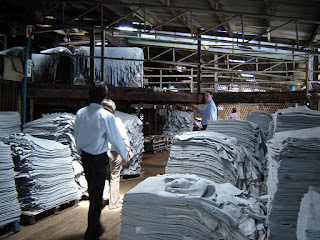We only purchase finished hides and then, do the cut and sew to turn them into leather sofa covers. However, we do get involved with the leather tanneries when it comes to developing new products or addressing certain quality issues, and I often must visit these tanneries both in Thailand and around the world.
Here I am at a tannery in Thailand.

There are several stages in the tanning process which I will attempt to describe below:
Faces of Death Stage (No Picture)
This is the slaughterhouse stage. Fortunately, I have not seen this stage myself, but some of our customers are asking whether or not the cows killed for our hides are slaughtered in a humane manner. Ask the cows, but don't ask me to take a look at it myself.
Vegetarian Stage
At this stage, raw cow skins come into the tannery that have been purchased from a local slaughterhouse. The hides still have hair and globules of fat hanging off the underside. This is as close as I wanted to get.
In this picture, the guy is cutting off the excessive fat and throwing it into a bin. At this point, you agree never to eat meet again - especially, sausage at the restaurant next door.
The 12 Fingers Stage
At this stage, a toxic recipe of chemicals are added that remove the hair and fat (of the cow hides). These chemicals, also, preserve the hides so they maintain their flexibility, strength, and softness, but don't rot.

These guys aren't wearing shirts or shoes.

This mix of chemicals, in particular the Chrome, have become a growing concern among environmentally-friendly retailers, and a new "Chrome-Free" process has been developed that uses different chemicals. The true benefit of these 'new chemicals' is that we don't yet know what the adverse affects truly are, so what you don't know can't hurt you.
Oddly enough, the mix of these chemicals turns the hides a baby blue color. At this point, they are no longer referred to as hides, but affectionately called "wet blues"
Nothing is wasted. The hair is taken to make brushes, the fat is used to make dog food (I think), and the shavings of the wet blue are used to make more leather. Some less-scrupulous leather suppliers take these shavings, mix it will glue and rubber, and sell it as a leather.

100% All-Natural Leather Stage
Maybe I was a bit naive, but before I started working here, I thought the print on your leather sofa was a natural characteristic of the cow's skin - not so. I even thought that fresh, new car smell came from the leather - not so. Well, it does comes from the leather, but only from all the chemicals and paints that have been applied. And the print can come in any number of designs and styles. A popular one is called a Madras print. Next you're going to tell me there's no Easter Bunny.
In this picture the Wet Blue is being dried and stretched. More stretch = more leather you can sell.
In this picture, the worker is applying stucco to cover any holes, deep scars, or bug bites.
After being soaked in chemicals, shaved, stretched, patched, painted, printed, and sealed, you get something like this.

Or this... (the hole comes from the cow's hump)

Which eventually, becomes this.






No comments:
Post a Comment